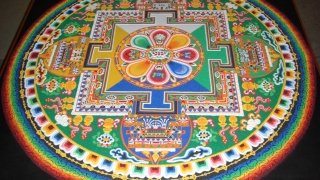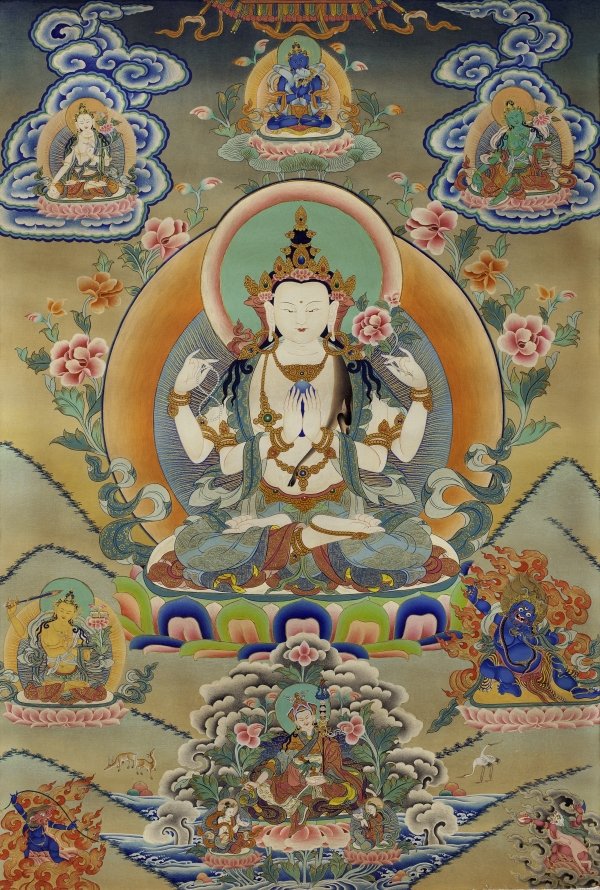
Exhibition: Tibetan Buddhist "Chenrezig" Sand Mandala Healing and Compassion in Challenging Times
Opening ceremony: Monday, October 21, at 10 am in the Art Gallery, Haudenosaunee Thanksgiving Address with Akwesasne artist Katsitsionni Fox, followed by Tibetan Buddhist ritual opening ceremony with monks from Namgyal Monastery
Chenrezig (in Sanskrit, Avalokiteśvara) personifies compassion, the most important ethical value in Buddhism. Many Buddhists, especially Tibetan Buddhists, perform a contemplative practice in which they visualize themselves as Chenrezig and imagine that in his form they are able to relieve the suffering of living beings throughout the cosmos.
The Chenrezig mandala (“circle”) is an architectural ground plan of Chenrezig’s palace, its gardens and decorations, at the center of the cosmos. Practitioners of Chenrezig meditation imagine that it is the abode from which they spread their compassion.
Because a sand mandala is usually made for the purpose of initiating meditators into a specific practice, it is a temporary construction. At the initiation’s conclusion, the sand is dispersed in a body of water. In recent years, however, mandalas have been constructed in public places such as art galleries and museums for educational purposes.
Made of millions of grains of sand, thought to be charged with powerful blessings, a sand mandala is painstakingly constructed over a period of days or weeks. Every aspect of it has symbolic significance. For instance, Chenrezig himself appears in the center of a lotus flower on a moon disc; the outer walls of the mansion, in layers of white, yellow, red, green, and blue, represent faith, effort, memory, meditation, and wisdom; and the four doorways represent the four “immeasurable thoughts” of love, compassion, sympathetic joy, and equanimity.
Tibetan Buddhists believe that simply viewing a mandala can put the observer in touch with the profound potential for perfect enlightenment that exists within every mind. During a post-Covid era of heightened psychological and emotional duress, here and around the world, the Chenrezig sand mandala offers wholeness, balance, unity, connection, and harmony.
-Daniel Cozort, Religious Studies professor emeritus, Dickinson College
-Catherine Tedford and Catherine Shrady, organizers
Several traditional Tibetan Buddhist thangka paintings from the Gallery’s permanent collection and regional lenders will also be on display. Typically used for devotional purposes, thangka paintings depict Buddhist deities, teachings, or mandalas, such as the Wheel of Life, which illustrates the cyclic existence of life, death, and rebirth.

As cultural ambassadors from the exiled personal monastery of His Holiness the Dalai Lama in Dharamsala, India, the monks of Namgyal Monastery Institute of Buddhist Studies, Ithaca, New York, have become especially well known for the creation of sand mandala exhibitions in museums and galleries throughout the world. Two monks from Namgyal will be in residence for the duration of the project. Chenrezig was chosen by the monks as a form of healing and compassion in response to current events around the world.
Events in conjunction with the exhibition: All are free and open to the public
- Monday, October 21, at 7 pm in Griffiths 123. “Mandala: Imagining a Better World,” lecture by Daniel Cozort
- Tuesday, October 22, at 11:00 a.m. and 3:00 p.m. in the Gallery. Informal discussions with Daniel Cozort
- Thursday, October 24, at 12:00 p.m. in the Gallery. “Introduction to Tibetan Buddhism,” lecture and discussion with monks
- Wednesday, October 30, at 6:30 p.m. in Griffiths 123. “Caring for Our Only Home: A Buddhist Response to the Climate Crisis,” lecture and discussion with Shinge Roshi, abbot of the Zen Center of Syracuse Hoen-Ji
- Thursday, October 31, at 12:00 p.m. in the Gallery. Meditation instruction with monks
- Friday, November 1, at noon in the Gallery. “Spotlight talk” by Dr. Chandreyi Basu, associate professor of Art & Art History, on Eight Manifestations of Guru Rinpoche, a Tibetan Buddhist thangka painting from St. Lawrence University’s permanent collection
- Thursday, November 7, at 12:00 p.m. in the Gallery. “How to achieve peace in troubled times,” discussion with monks
- Friday, November 8, at 12:00 p.m. in Griffiths 123. “Mandalas in Japanese Buddhism” lecture by Dr. Mark MacWilliams, professor of Religious Studies
- Saturday, November 16, at 12:00 p.m. at the Gallery. Ritual dismantling ceremony and walk to Willow Island to disperse the sand in the Grasse River
The Gallery will be open Monday through Thursday 10 am - 8 pm; Friday 10 am - 5 pm; and Saturday and Sunday 12 - 5 pm. St. Lawrence University’s Arts Collaborative provided major funding for the exhibition and related programs; special thanks also to the departments of Religious Studies, Philosophy, and Environmental Studies.
